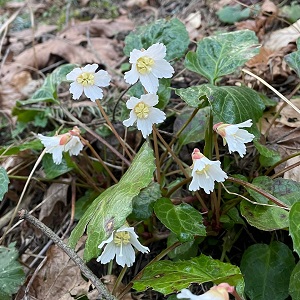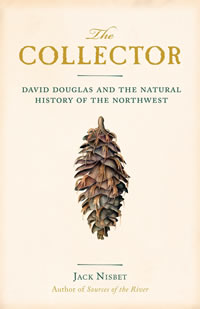![[The Multifarious Mr. Banks] cover](https://depts.washington.edu/hortlib/graphix/multifariousmrbanks300.jpg)
Joseph Banks was indeed multifarious. Webster defines the term as “having or occurring in great varieties.” Garden lovers might know that Banks became famous after collecting plants on a round-the-world voyage with Captain Cook on the Endeavour in 1768-71, and that he developed and guided Kew Gardens for decades. Toby Musgrave does justice to these huge accomplishments. What he adds is the astonishing range of other ways that Banks influenced the horticultural world – and often other worlds – in late 18th and early 19th century England and beyond.
The book is organized chronologically through the account of Banks’s Endeavour voyage and a smaller one to Iceland, but then proceeds by subject through other areas of Banks’s activities.
Banks was very wealthy. He was endlessly curious. He apparently knew everyone of any importance in England and many others on the Continent and in America. He had an outgoing and friendly personality. James Boswell describes him as “an elephant, quite placid and gentle, allowing you to get upon his back or play with his proboscis,” (p. 187), as opposed to another world traveler (Scottish explorer James Bruce) who was “a tiger that growled whenever you approached him.”
Banks was also a firm believer in progress and in empire (which 21st century readers might be less enthusiastic about). Musgrave shows us Banks’s close relationship with King George III, that nemesis of the American Revolution. “Farmer George,” as the king was called, loved Kew Gardens and walked in it with Banks regularly. In Banks’s decades-long efforts finding new plants and acquiring them for Kew, he remained focused on how plants could be used as crops or resources to aid the empire.
Banks belonged to more that 70 clubs and societies. It’s hard to imagine how he did all this and still managed his own multiple properties, regularly updating them with new planting plans. The most prominent society activity for him was his position as president of the Royal Society, a title he held for 41½ years beginning in 1778. In all these activities Banks assisted other scientists in a multiplicity of areas, giving counsel, offering connections, and sometimes providing cash.
When England needed a new site for prisoners, after Georgia was no longer available due to American independence, Banks weighed in on proposing Botany Bay in Australia as an appropriate location. He also pulled strings and even arranged smuggling a prize breed of Merino sheep from Spain, to the benefit of Australia as well as England.
Through his connections and frequent correspondence with members of the Lunar Society of Birmingham (which included Erasmus Darwin, Benjamin Franklin, and Joseph Priestly), with a great many others, and through his own study, “Banks became an acknowledged expert in a wide range of subjects including agriculture, botanic gardens, canals, cartography, coinage, colonization, currency, drainage, earthquakes, economic botany, exploration, farming, leather tanning, Merino sheep, plant pathology, and even the plucking of geese” (p. 281). Multifarious indeed.
This is a real biography, based on copious research. Musgrave avoids fictional conversations and mostly stays away from suggesting what Banks “must have thought.” Fortunately, the author is not afraid to express an opinion, such as that Banks behaved very badly in breaking his engagement to Harriet Blosset. Mostly the story Musgrave tells is one of amazing positives, ending with his justified assessment of Banks as a “great and remarkable man”(p. 332).
Published in the Leaflet, November 2021, Volume 8, Issue 11.

 Today raft trips through the Grand Canyon are common. Several companies offer choices of a few or many days. One specifies that the client must be at least nine years old. These trips differ greatly from the one Elzada Clover and Lois Jotter took in 1938. One difference is the Hoover Dam. Before the dam, the Colorado River challenged travelers with extreme rapids, rapids now slowed and sometimes covered by the water that rose behind the dam.
Today raft trips through the Grand Canyon are common. Several companies offer choices of a few or many days. One specifies that the client must be at least nine years old. These trips differ greatly from the one Elzada Clover and Lois Jotter took in 1938. One difference is the Hoover Dam. Before the dam, the Colorado River challenged travelers with extreme rapids, rapids now slowed and sometimes covered by the water that rose behind the dam. The National Herbarium of New South Wales, Australia, acts as setting and springboard for Prudence Gibson’s narratives about and descriptions of preserved plants. Gibson holds in admirable tension the wonders of the herbarium and the troubling colonialism that assumed authority over Australia’s plants, collecting them without permission, naming and organizing them by European standards. The question of who owns plants hovers in the background.
The National Herbarium of New South Wales, Australia, acts as setting and springboard for Prudence Gibson’s narratives about and descriptions of preserved plants. Gibson holds in admirable tension the wonders of the herbarium and the troubling colonialism that assumed authority over Australia’s plants, collecting them without permission, naming and organizing them by European standards. The question of who owns plants hovers in the background. “Just imagine it: your parents on their hands and knees groping at a swarm of crickets unleashed from an upturned box; your teenage sister screaming at toads spawning in the bath; squirting cucumbers launching a raid of missiles down the stairs; and the gut-wrenching stench of a freshly unfurled dragon arum wafting through the front door. This is what I subjected my family to.” (p. 7)
“Just imagine it: your parents on their hands and knees groping at a swarm of crickets unleashed from an upturned box; your teenage sister screaming at toads spawning in the bath; squirting cucumbers launching a raid of missiles down the stairs; and the gut-wrenching stench of a freshly unfurled dragon arum wafting through the front door. This is what I subjected my family to.” (p. 7)![[The Multifarious Mr. Banks] cover](https://depts.washington.edu/hortlib/graphix/multifariousmrbanks300.jpg)
![[The Food Explorer] cover](https://depts.washington.edu/hortlib/graphix/foodexplorer300.jpg)
![[The Brother Gardeners] cover](https://depts.washington.edu/hortlib/graphix/brothergardeners.jpg)
 While you’re browsing the tables at your favorite plant sale or nursery, you may notice that many of the plant treasures tempting you have “henryi” or some similar variation in their name. In most cases, these honor Augustine Henry, the Irish customs official who worked for the Chinese government in western China during the 1880s and 1890s.
While you’re browsing the tables at your favorite plant sale or nursery, you may notice that many of the plant treasures tempting you have “henryi” or some similar variation in their name. In most cases, these honor Augustine Henry, the Irish customs official who worked for the Chinese government in western China during the 1880s and 1890s. Sir Joseph Dalton Hooker: Traveler and Plant Collector (2001) by Ray Desmond is a marvelous travelogue, masking as a biography. Our hero took two multi-year expeditions (to Antarctica, New Zealand, and Australia from 1839-1843; and to India and the Himalayas from 1847-1851) as well as shorter trips to Morocco, Palestine, and the United States.
Sir Joseph Dalton Hooker: Traveler and Plant Collector (2001) by Ray Desmond is a marvelous travelogue, masking as a biography. Our hero took two multi-year expeditions (to Antarctica, New Zealand, and Australia from 1839-1843; and to India and the Himalayas from 1847-1851) as well as shorter trips to Morocco, Palestine, and the United States. For a total change of pace, pick up Jack Nisbet’s “The Collector.” Although written in the third person, the story-telling is so good that it reads like a memoir by one of the most influential of the early plant explorers to our region. David Douglas was a keen observer of all things in the natural world, but especially the plant kingdom, and had a natural talent for the recording, collecting, and preserving what he found. And what energy! From 1823 until his tragic death in 1834, Scotsman Douglas was almost constantly exploring the new world, risking many hazards of travels and meeting many interesting people in both academic and frontier life.
For a total change of pace, pick up Jack Nisbet’s “The Collector.” Although written in the third person, the story-telling is so good that it reads like a memoir by one of the most influential of the early plant explorers to our region. David Douglas was a keen observer of all things in the natural world, but especially the plant kingdom, and had a natural talent for the recording, collecting, and preserving what he found. And what energy! From 1823 until his tragic death in 1834, Scotsman Douglas was almost constantly exploring the new world, risking many hazards of travels and meeting many interesting people in both academic and frontier life.